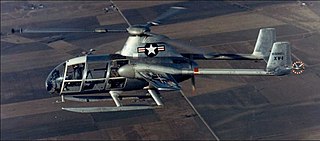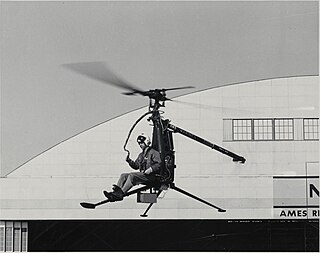The Aer Lualdi L.55 was a prototype Italian helicopter, a development of the Lualdi-Tassotti ES 53 featuring a far more powerful 134 kW (180 hp) Lycoming O-360. While the ES 53 had been purely experimental, the L.55 was Lualdi's first step towards a marketable aircraft.

The Fairey FB-1 Gyrodyne is an experimental British rotorcraft that used single lifting rotor and a tractor propeller mounted on the tip of the starboard stub wing to provide both propulsion and anti-torque reaction.

The NHI H-3 Kolibrie was a small helicopter developed in the Netherlands in the 1950s by Nederlandse Helikopter Industrie. It first flew in May 1956.
The SNCASE SE.3120 Alouette ("Lark") was a utility helicopter developed in France in the early 1950s but which did not enter production. Designed in parallel with the SE.3110, the Alouette shared that machine's dynamic components, with the exception of the SE.3110's unusual twin tail rotor, which was replaced by a single rotor, and the addition of a three-bladed gyroscopic stabiliser under the main rotor (similar to the stabiliser bar used by Bell helicopters. The Alouette featured an open-framework fuselage behind a cockpit that was enclosed by a bubble canopy. Skid undercarriage and tricycle gear were both tested.
The Manzolini Libellula was a 1950s Italian co-axial twin-rotor helicopter designed by Ettore Manzolini. "Libellula" is the Italian word for "Dragonfly".

The Doman LZ-5 was a utility helicopter developed in the United States in the early 1950s by Doman Helicopters Inc. of Danbury, Connecticut. Despite the procurement of international manufacturing agreements, no series production of the aircraft ever occurred, and only three prototypes were built. Two of these were purchased by the United States Army as the YH-31, but eventually becoming VH-31.

The McDonnell XV-1 is an experimental Convertiplane developed by McDonnell Aircraft for a joint research program between the United States Air Force and the United States Army to explore technologies to develop an aircraft that could take off and land like a helicopter but fly at faster airspeeds, similar to a conventional airplane. The XV-1 would reach a speed of 200 mph, faster than any previous rotorcraft, but the program was terminated due to the tip-jet noise and complexity of the technology which gave only a modest gain in performance.
The Fiat Model 7002 was a 1960s Italian general-purpose helicopter with a tip jet driven rotor built by Fiat Aviazione. Only one aircraft was built.

The Gyrodyne RON Rotorcycle was a tiny, single-seat helicopter designed under contract for the United States Navy. in the mid-1950s. It later was redesigned for a U.S. Marine Corps requirement for a small personal helicopter that would fulfill a number of roles, including observation, liaison, small unit tactical maneuvers, and which could be dropped to downed airmen behind enemy lines to facilitate their escape.

The Kellett XR-10 was a military transport helicopter developed in the United States in the 1940s that only flew in prototype form. It was designed in response to a USAAF Technical Instruction issued for the development of a helicopter to transport passengers, cargo, or wounded personnel within an enclosed fuselage. Kellett's proposal followed the general layout that the company was developing in the XR-8, with twin intermeshing rotors, and was accepted by the Air Force on 16 October over proposals by Sikorsky, Bell, and Platt-LePage.

The Piasecki H-16 Transporter was a tandem-rotor transport or rescue helicopter designed by Frank Piasecki and built by Piasecki Helicopter. The prototypes were evaluated by the United States Air Force and Army, but the crash of the second test aircraft led to cancelling the project.

The Hiller ROE Rotorcycle was a single-seat ultralight helicopter designed in 1953 for a military requirement. A total of 12 were produced for the United States Marine Corps. And in 1954, the Hiller Helicopters was selected by the US Navy's Bureau of Aeronautics to build this design of a one-man, foldable, self-rescue and observation helicopter. It featured a two-blade rotor system. Its original empty weight was 290 lb (132 kg).
The Nord 1750 Norelfe was a 1950s French three-seat helicopter built by Nord Aviation and designed by Jean Cantinieau.

The McDonnell XHJH Whirlaway, aka McDonnell Model 65, was a 1940s American experimental transverse-rotor helicopter designed and built by McDonnell Aircraft Corporation for the United States Navy and was the largest helicopter at the time, as well as the first successful twin-engined twin-rotor helicopter in the world.
The I.P.D BF-1 Beija-Flôr was a two-seat light helicopter designed by Henrich Focke.
The Goodyear GA-400R Gizmo was a one-man helicopter proposed for duties such as liaison and observation.

The SNCASE SE-3101 or Sud-Est SE-3101 was an early, experimental French helicopter with twin tail rotors. Only one was built.

The Transcendental Model 1-G was an experimental American tiltrotor prototype of the 1950s. It was a single-seat aircraft powered by a single piston engine, and was the first tiltrotor to fly. A single example was built, which was destroyed in a crash in 1955.

The Hoppi-Copter was a functional backpack helicopter developed by the American company Hoppi-Copters Inc. founded by Horace T. Pentecost in the 1940s. The original Hoppi-Copter consisted of two contra-rotating rotors on a pole attached to a motorized backpack. Although it was capable of flight, it was extremely hard to control.
The Kaman K-17 was a two-seat experimental helicopter built by Kaman in the late 1950s. It used a cold-jet rotor system.












